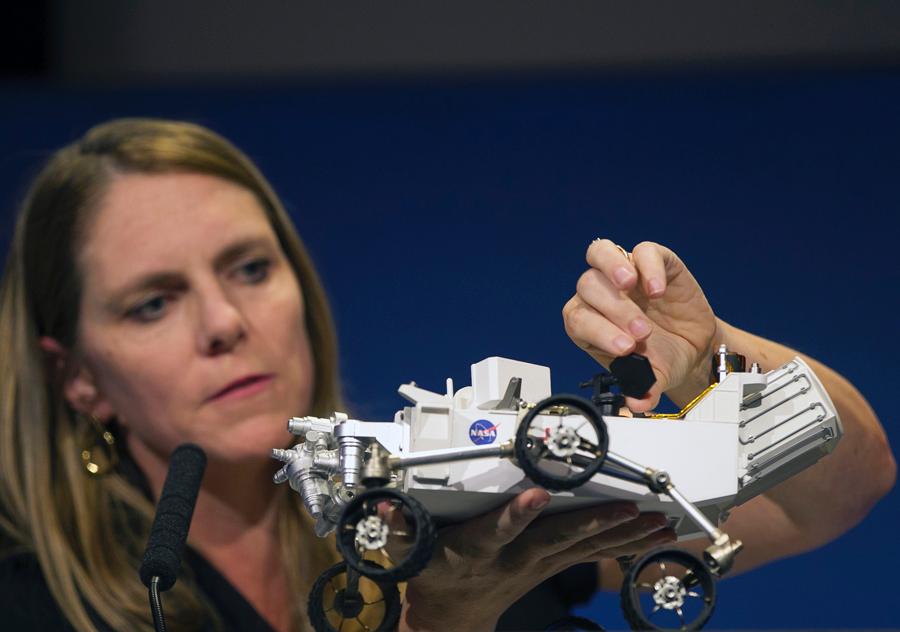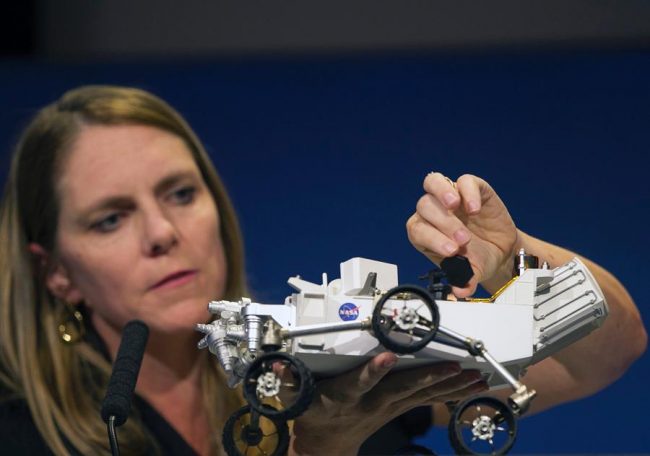
A NASA scientist presents a model of Curiosity to a room of reporters days before Curiosity reached Mars. (AP)
At 12:31am on Aug. 6, while the rest of the world focused on the Olympics, space geeks jumped for joy.
On Nov. 26, 2011, NASA’s new mobile laboratory, the Curiosity rover, left our planet; it travelled approximately 352 million miles (567 million kilometers) in about 252 Earth days with no issues.
However, for the last 13.8 minutes of its journey (the time it takes to receive the data from Mars), many people crossed their fingers as a $2.5 billion dollar project gave a newly developed landing procedure its first test. NASA aptly describes the craft’s landing as “seven minutes of hell.”
In this time, the craft had to go from its travelling speed of 13,200 mph (5600 meters/s) and decelerate to a near stop to drop Curiosity inside the Gale Crater, at the base of Mount Sharp, on the surface of Mars.
While the world was focused on the competitions in London, 154 million miles away, Curiosity stuck the landing after a new feat of robotic gymnastics.
This new landing technique involves a massive S-turn that begins by diving into the atmosphere from an altitude of seventy-eight miles before curving up only seven miles above the surface. The friction generated in the 254 seconds process of this dive slows the craft to approximately 900 mph, where it deploys its parachute.
Two miles closer to the ground and 24 seconds later, the heat shield comes off, the radar begins to gather data, and the craft travels only approximately 280 mph; a mile above ground. Six minutes from the time of entry, the back shell and parachute separate at approximately 180 mph.
Here, Curiosity’s last attachment (called the Sky Crane) begins to fire rockets and slow the nearly vertical descent. At about 66 feet above ground, the rockets nearly overcome the downward momentum of the landing and the rover is lowered by the Sky Crane, touching the ground at only about 1.7 mph.
At about 416 seconds from entry, the cables detach from the grounded rover and the rockets, suddenly relieved of the additional weight, shoot the Sky Crane safely away from Curiosity.
Previously, Mars rovers were slowed as much as possible and then essentially made into bouncy balls by deploying airbags around the craft; then they simply bounced to a stop.
This technique limited the possible size and weight of the rovers and prevented landings in areas near any hazardous terrain.
The newly developed landing method resulted in a five-fold increase in landing precision (reducing the length of the landing zone to twelve miles) and allows for much heavier payloads. Curiosity was able to be designed with less concern on weight and land safely in the hazardous surroundings of the prime candidate for scientific discovery. It took scientists over 100 scientists five years to make.
Now the craft can begin its true mission: to examine Mars’ Gale Crater for evidence of either past or present habitable environments. Gale Crater was selected not for its likelihood of present life, but for the probability it contains rock and soil that originated from a multitude of different areas and time periods.
As NASA describes in the “Mars Science Laboratory Landing Press Kit,” Curiosity “is the prospecting stage of a step-by-step program . . . for a definitive answer about whether life has existed on Mars.”
The craft is designed with this mission goal completely in mind. Curiosity measures 9’10” long, 9’1″ wide, and 7′ tall.
It rides on six 20 inch wheels, has a 7 feet long arm, and weighs in at 1,982 lbs. That’s roughly double the length and five times the weight of its predecessors, Spirit and Opportunity.
Curiosity uses the radioactive isotope Plutonium-238 in an electrothermal generator, which powers various aspects of the rover and provides the excess heat needed to warm the liquids plumbed through the craft to keep it in an operable temperature range.
The slow decaying radioisotope and a number of lithium ion batteries are expected to power the rover for a full Martian year (687 Earth days) and chances are probable it will last even longer. It can travel 660 feet per day.
More importantly, ten complex instruments make up the science payload Curiosity will utilize in its mission. Curiosity is the first rover that is capable of gathering, processing and analyzing rock and soil samples.
Using its array of equipment and under the day-to-day control of a globally diverse group of scientists, Curiosity can examine the differing areas of Gale Crater and provide a massive leap forward in the understanding of Mars as a whole.
No matter what kind of data Curiosity finds, it will deeply improve our understanding of the Red Planet and dramatically influence any subsequent missions to Mars.









